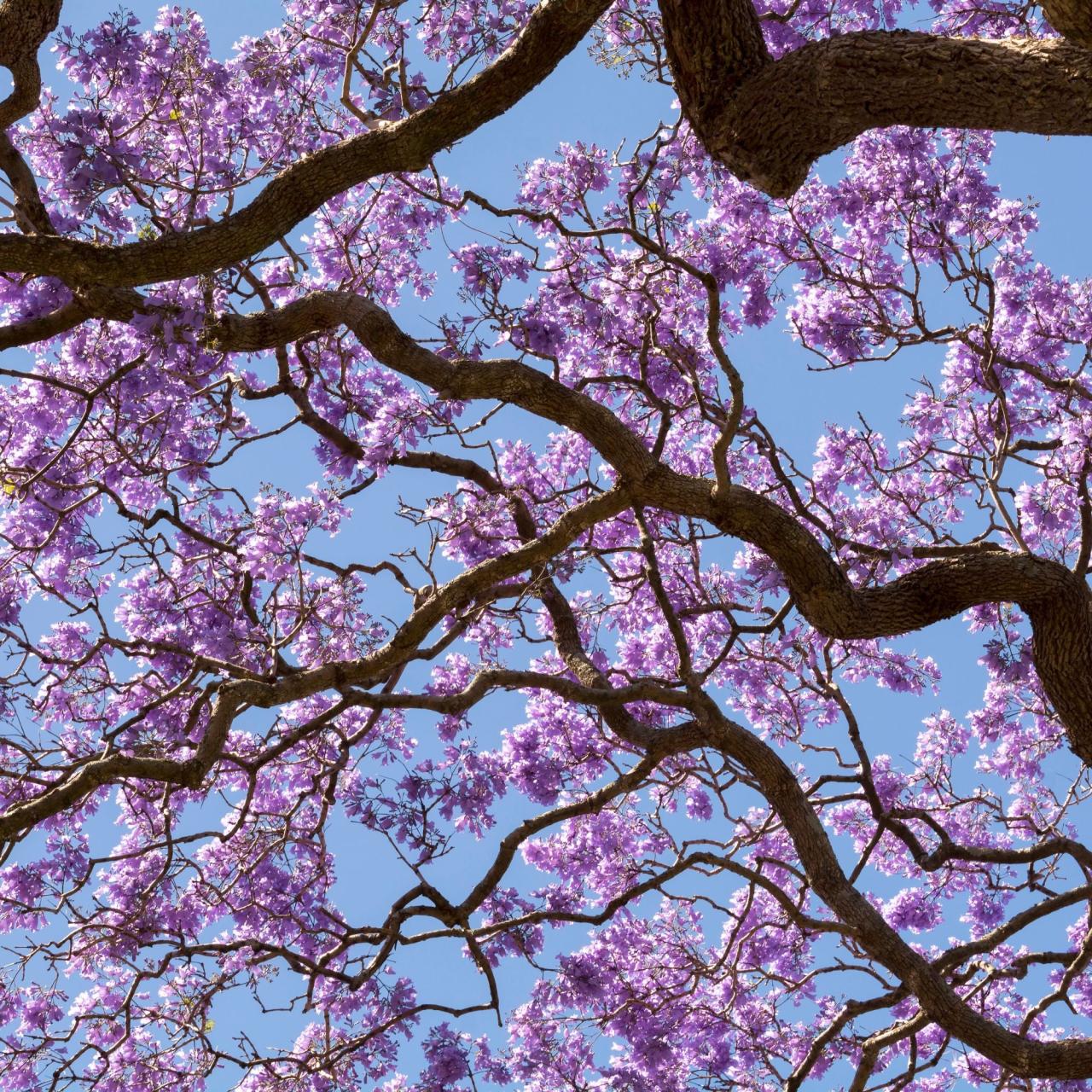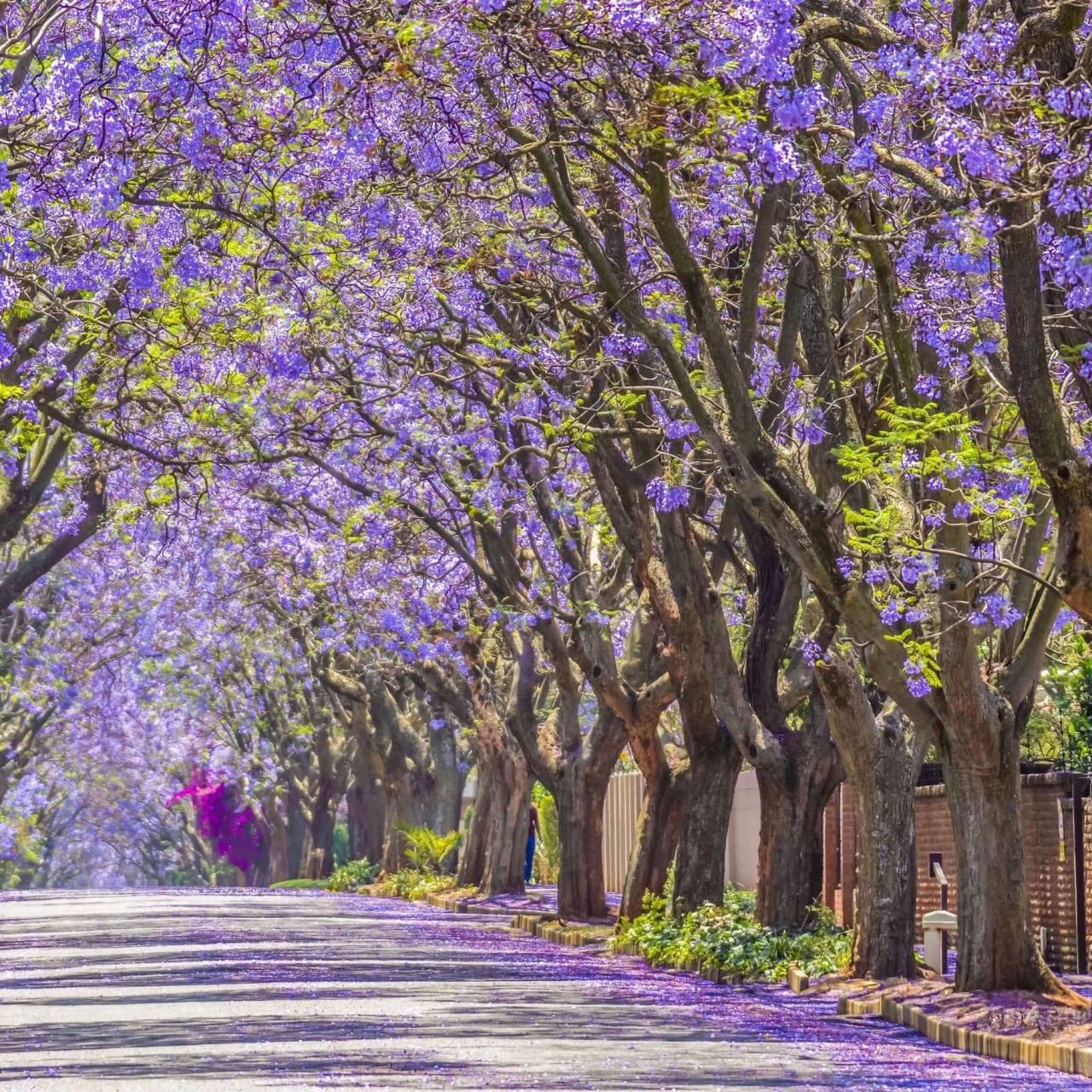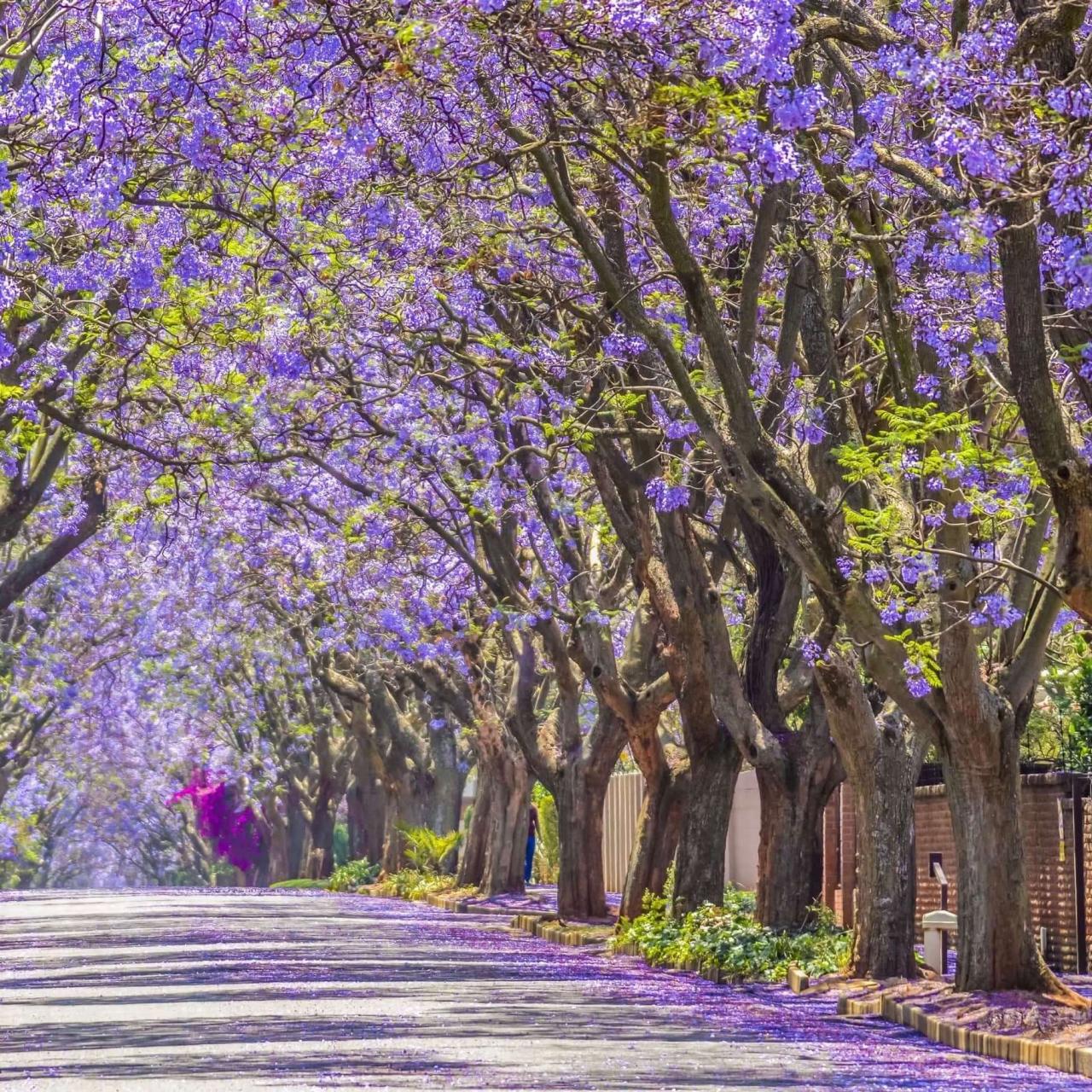Discover the Beauty of Jacaranda Tree: How to Grow and Care for This Stunning Tree. The Jacaranda tree, with its vibrant purple blooms, is a sight to behold. Native to South America, this species has become a beloved fixture in gardens and landscapes worldwide.
Its captivating beauty, coupled with its unique cultural significance, makes the Jacaranda tree a compelling choice for those seeking to add a touch of exotic charm to their outdoor spaces. Beyond its aesthetic appeal, the Jacaranda tree also offers a glimpse into the fascinating world of botany and its role in attracting pollinators.
This guide will delve into the origins, cultural symbolism, and distinctive features of the Jacaranda tree. We’ll explore the best practices for planting and caring for this remarkable species, ensuring its healthy growth and continued beauty. From understanding its ideal climate and soil conditions to mastering the art of pruning, this comprehensive guide will equip you with the knowledge you need to cultivate your own Jacaranda tree.
Introduction to the Jacaranda Tree
The Jacaranda tree, scientifically known asJacaranda mimosifolia*, is a stunning and iconic tree native to South America, specifically in countries like Argentina, Bolivia, and Brazil. Its captivating beauty and vibrant blooms have made it a beloved sight across the globe, particularly in warm climates.
The Jacaranda tree, with its vibrant purple blooms, is a stunning addition to any landscape. Just like cultivating a beautiful Jacaranda, growing a citronella plant successfully requires careful attention. Learn how to nurture this natural insect repellent by reading our guide on How to Grow Citronella Plant Successfully: Tips for a Healthy and Effective Herb.
With the right care, both your Jacaranda and citronella plants will thrive, creating a beautiful and aromatic outdoor space.
This tree’s journey from its South American origins to its widespread popularity around the world is a testament to its enduring appeal. The Jacaranda tree has become a symbol of beauty, joy, and springtime in many cultures, adorning landscapes and capturing hearts wherever it takes root.
Cultural Significance and Symbolism
The Jacaranda tree holds significant cultural meaning in various parts of the world. In South Africa, where it thrives, the Jacaranda blooms coincide with the university examination period. This association has led to the tree being affectionately nicknamed the “exam tree,” with the belief that its flowers bring good luck to students.
- Symbol of Spring:In many countries, the Jacaranda tree’s vibrant purple blossoms signal the arrival of spring, symbolizing new beginnings, hope, and renewal.
- Symbol of Love and Romance:In some cultures, the Jacaranda tree is associated with love and romance, its delicate flowers representing affection and beauty.
- Symbol of Peace and Tranquility:The Jacaranda tree’s graceful canopy and serene beauty evoke feelings of peace and tranquility, making it a popular choice for parks and gardens.
Interesting Facts about the Jacaranda Tree
The Jacaranda tree is not only visually captivating but also boasts several intriguing characteristics:
- Lifespan:Jacaranda trees can live for up to 50 years, with some specimens reaching over 100 years old.
- Pollinators:The Jacaranda tree’s fragrant flowers attract a variety of pollinators, including bees, butterflies, and hummingbirds, contributing to the ecosystem’s biodiversity.
- Wood:The Jacaranda tree’s wood is prized for its durability and beautiful grain, making it suitable for furniture and other woodworking projects.
The Beauty of the Jacaranda Tree
The Jacaranda tree is renowned for its stunning beauty, captivating onlookers with its vibrant blooms and elegant foliage. This captivating tree adds a touch of magic to any landscape, transforming urban streets into breathtaking avenues of purple and blue.
Distinctive Features of the Jacaranda Tree
The Jacaranda tree possesses a unique combination of features that contribute to its captivating beauty. Its delicate, fern-like leaves create a soft, airy canopy that filters sunlight, casting dappled shadows on the ground below. The leaves are a beautiful shade of green, providing a striking contrast to the vibrant blooms.
The bark of the Jacaranda tree is typically smooth and gray, sometimes developing a slightly rough texture with age.
The Vivid Hues of Jacaranda Flowers
The Jacaranda tree’s most striking feature is its abundance of flowers, which appear in clusters at the ends of branches. These flowers are a vibrant shade of purple or blue, with a range of variations depending on the specific species and cultivar.
Some Jacaranda flowers exhibit a deep, rich purple, reminiscent of amethyst, while others display a lighter, more delicate lavender hue. The flowers are also known for their trumpet-shaped form, adding a touch of elegance and sophistication to the overall appearance of the tree.
Landscaping and Urban Design Applications
The Jacaranda tree’s aesthetic appeal makes it a popular choice for landscaping and urban design projects. Its graceful form, vibrant blooms, and ability to provide shade make it an ideal tree for parks, gardens, and streetscapes. Jacaranda trees are often planted along avenues, creating a breathtaking canopy of purple and blue that transforms urban environments into picturesque landscapes.
In some cities, such as Pretoria, South Africa, Jacaranda trees are so prevalent that they have become synonymous with the city itself. During the spring, the city is blanketed in a sea of purple blooms, creating a truly magical atmosphere.
Growing a Jacaranda Tree: Discover The Beauty Of Jacaranda Tree: How To Grow And Care For This Stunning Tree

Cultivating a Jacaranda tree in your garden can be a rewarding experience, adding a touch of tropical beauty to your landscape. Understanding the tree’s requirements and following the right steps will ensure a healthy and thriving Jacaranda.
Ideal Climate and Soil Conditions
Jacaranda trees thrive in warm climates with ample sunshine and well-drained soil. They are native to tropical and subtropical regions of South America and are commonly found in areas with a Mediterranean climate.
- Temperature:Jacaranda trees prefer warm temperatures and can tolerate some frost, but prolonged exposure to freezing temperatures can damage or kill the tree. Ideally, they thrive in regions with average annual temperatures between 65°F and 85°F (18°C and 29°C).
- Sunlight:Jacaranda trees need at least 6 hours of direct sunlight daily for optimal growth. They can tolerate partial shade, but their flowering may be reduced in shaded conditions.
- Soil:Jacaranda trees prefer well-drained soil with a slightly acidic to neutral pH (6.0 to 7.0). They are adaptable to various soil types, including sandy loam, clay loam, and even rocky soils, as long as drainage is good. Poor drainage can lead to root rot.
Planting a Jacaranda Tree
Planting a Jacaranda tree involves several steps to ensure its successful establishment.
- Choose the right location:Select a spot that receives ample sunlight and has well-drained soil. Consider the mature size of the tree, as it can reach heights of 40 to 60 feet (12 to 18 meters). Ensure the planting site is away from buildings, power lines, and underground utilities.
- Prepare the soil:Dig a hole twice as wide and as deep as the root ball of the sapling. Amend the soil with compost or aged manure to improve drainage and provide nutrients. Remove any rocks or debris from the planting area.
- Plant the sapling:Gently remove the sapling from its container and loosen the roots. Place the sapling in the hole, ensuring the top of the root ball is level with the ground. Backfill the hole with the amended soil, firming it gently around the roots.
- Water thoroughly:After planting, water the sapling deeply to settle the soil and encourage root development. Continue to water regularly, especially during dry periods, until the tree is established.
Best Time to Plant a Jacaranda Tree, Discover the Beauty of Jacaranda Tree: How to Grow and Care for This Stunning Tree
The best time to plant a Jacaranda tree is during the spring or early summer, when the weather is warm and there is adequate moisture. This allows the tree to establish its roots before the onset of colder temperatures. In warmer climates, planting can be done throughout the year.
Caring for a Jacaranda Tree
Caring for a Jacaranda tree is relatively simple, but it does require some attention to ensure its health and longevity. This section will provide you with the necessary information to keep your Jacaranda thriving.
Watering Requirements
Jacaranda trees are drought-tolerant once established, but they benefit from regular watering, especially during their first few years of growth.
- Young trees need consistent moisture to establish a strong root system. Water them deeply once or twice a week, ensuring the soil is thoroughly soaked.
- Mature trees, on the other hand, can tolerate periods of drought, but they will flourish with occasional deep watering, especially during hot and dry spells.
- It’s important to avoid overwatering, as this can lead to root rot. Check the soil moisture before watering, and only water when the top few inches of soil are dry.
Fertilizing a Jacaranda Tree
Fertilizing your Jacaranda tree is crucial for its healthy growth and vibrant flowering.
- Use a balanced fertilizer, such as a 10-10-10 formula, to provide the necessary nutrients for your tree.
- Apply the fertilizer in the spring, before the tree starts to grow actively. You can also apply it again in the fall, but avoid fertilizing during the hottest months of summer.
- Follow the instructions on the fertilizer packaging for the correct application rate.
Pests and Diseases
Jacaranda trees are generally resistant to pests and diseases, but they can be susceptible to certain issues.
- Common pestsinclude aphids, scale insects, and mealybugs. These pests can be controlled by using insecticidal soap or horticultural oil.
- Common diseasesinclude root rot, leaf spot, and powdery mildew. Root rot can be prevented by ensuring good drainage and avoiding overwatering. Leaf spot and powdery mildew can be treated with fungicides.
Pruning a Jacaranda Tree
Pruning a Jacaranda tree is essential for maintaining its shape and size, as well as promoting healthy growth.
The Jacaranda tree, with its stunning purple blooms, is a beautiful addition to any landscape. However, like many plants, it can be susceptible to pests. To keep your Jacaranda healthy and thriving, consider incorporating natural pest control methods, such as using citronella plants.
Discover the Benefits of Citronella Plant: How to Use It for Natural Pest Control can provide valuable insights into this natural pest repellent, which can be used in conjunction with other care practices to ensure your Jacaranda flourishes.
- The best time to prune a Jacaranda tree is in the late winter or early spring, before the tree begins to grow actively.
- Remove any dead, diseased, or damaged branchesto improve the tree’s overall health and appearance.
- Prune back any branches that are growing too close togetherto improve air circulation and prevent disease.
- You can also prune the tree to shape it, but be careful not to remove too much foliage at once.
The Jacaranda Tree in Different Cultures

The Jacaranda tree, with its vibrant purple blooms and graceful form, holds a special place in the hearts and minds of people around the world. Its presence in different cultures has led to a rich tapestry of folklore, symbolism, and celebration.
From South Africa to Australia and beyond, the Jacaranda tree has woven itself into the fabric of human experience, leaving its mark on art, literature, and everyday life.
The Jacaranda Tree in South Africa
In South Africa, the Jacaranda tree is deeply intertwined with the country’s cultural identity. Known as the “Jacaranda City,” Pretoria, the capital city, is renowned for its spectacular displays of purple blossoms during spring. The arrival of the Jacaranda season is eagerly anticipated, marking a time of joy, beauty, and celebration.
The Jacaranda tree is often associated with good luck and prosperity. A popular superstition suggests that if a Jacaranda flower falls on your head, you will soon experience good fortune. The tree’s presence is also linked to the academic world.
Students at the University of Pretoria believe that if a Jacaranda flower falls on them during exam season, they will pass their exams with flying colors.
The Jacaranda Tree in Australia
In Australia, the Jacaranda tree has become a beloved symbol of spring and the arrival of warmer weather. The sight of the Jacaranda in full bloom evokes feelings of joy, nostalgia, and a sense of renewal. The tree is particularly prominent in Queensland, where it has become an integral part of the state’s cultural landscape.
The Jacaranda tree is also associated with the Australian tradition of “Jacaranda Day.” Celebrated in various towns and cities across the country, this special day features events, festivals, and celebrations that revolve around the beauty and cultural significance of the Jacaranda tree.
The Jacaranda Tree in South America
In South America, the Jacaranda tree is a symbol of beauty, resilience, and hope. Originating in the tropical regions of South America, the tree has long been admired for its vibrant blooms and its ability to thrive in challenging environments.In some parts of South America, the Jacaranda tree is associated with the spirit of the ancestors.
The tree’s presence is believed to provide a connection to the past and a sense of continuity across generations. In other regions, the Jacaranda tree is considered a symbol of love and romance. The tree’s delicate flowers and sweet fragrance are often used in traditional courtship rituals.
Ultimate Conclusion
Planting a Jacaranda tree is an investment in beauty, cultural heritage, and a vibrant ecosystem. With its stunning blooms and unique characteristics, this tree will grace your landscape with its presence for generations to come. By following the guidelines Artikeld in this guide, you can ensure the healthy growth and longevity of your Jacaranda tree, allowing it to become a cherished part of your outdoor sanctuary.
So, embark on this journey of cultivation, and witness the captivating beauty of the Jacaranda tree unfold in your own garden.
Clarifying Questions
What is the lifespan of a Jacaranda tree?
Jacaranda trees can live for several decades, with some reaching over 100 years old.
Are Jacaranda trees messy?
Jacaranda trees can be messy during the flowering season as they drop petals and seed pods. However, the mess is usually short-lived.
Are Jacaranda trees drought tolerant?
While Jacaranda trees are relatively drought tolerant, they thrive with regular watering, especially during their establishment phase.
